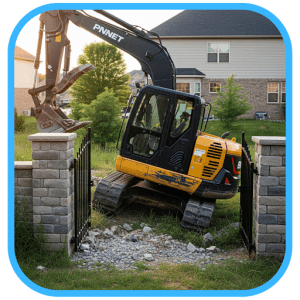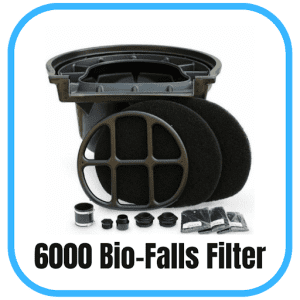What Affects the Cost of a Pond
13-15 minute read
By: John G Adams
Trying to figure out what kind of pond to put in your yard and not sure how much it’s gonna cost? It doesn’t matter what type of pond you’re thinking about, this guide lays it all out there. You’ll learn what affects pond pricing, why costs vary so much, what most companies don’t tell you, and how to choose the right pond for your lifestyle and budget. Real stories, real information, and transparent advice from a pond guy with 25 years of in-the-field experience!

Have you ever wondered why you can get two bids for a pond project—one for $25,000 and another for $60,000?
What I’ve found is that most people have no idea what actually drives pond pricing. And really—it’s not their fault. There’s barely any transparent info online that breaks this down in plain English. You try to ask around, and all you get is: “Well… it depends.”
Yeah. Thanks for nothing.
The fact that you’re even asking this question now before signing a contract you barely understand—means you’re already ahead of the game. Pond pricing isn’t just about money. It’s about avoiding mistakes. It’s about protecting your dream.
That’s what this article is about.
Since around 2000, my team & I have designed, built, & renovated hundreds of ponds—from small backyard goldfish setups to massive koi ponds with full-on swimming zones and features big enough to drop a kayak in. I’ve seen the magic that happens when we bring a dream to life. And I’ve also seen the heartbreak of folks who spent their entire dream budget… and didn’t get what they were dreaming of.
This article exists to help you avoid that scenario.
We’re going to walk through real cost factors that impact pond pricing—like pond size and depth, boulder selection, filtration systems, equipment access, drainage issues, even HOA restrictions. I’ll show you where you can trim costs without cutting corners—and where cutting too deep can cost you more in the long run.
Sometimes it’s smarter to do a high level of detail in a small space than to stretch your budget across your whole backyard. That kind of strategy makes the difference between a pond that fades into the background and one that becomes the centerpiece of your home.
By the time you’re done reading, you’ll have a practical understanding of what affects pond cost, what drives that number up or down, and what kind of water feature fits your budget and your lifestyle.
Because building a pond should be an educated decision.
It should be comfortable. Enjoyable. Honest.
It should feel like you’re building something that will bring your family together and give you a magical place to connect for years to come.
And it should never feel like a mystery.
Now, look—I’m aware that by writing this, I’m putting Modern Design Aquascaping in a position of authority. And yeah, of course I’d love for you to hire us.
But that’s not what this is.
This isn’t about selling you on Modern Design. The truth is, we’re not the right fit for everybody. That’s okay.
This is about giving you the real information. Sharing everything I’ve got between my ears, so you can make the best possible decision for you and your family. My goal is simple:
I want you to end up with the water feature of your dreams!
And that starts right here—with clarity, honesty, and zero pressure. So that all your surprises… are good ones.
How Much Does A Pond Cost?
I am adding this section in (at the end of my writing) to give you a straight answer at the beginning of the read! HOW MUCH? I have seen pond packages built out by my friends / competitors to meet price points as low as $8,500.00 installed. Companies like Easton Outdoors and Pond Country have done an amazing job building out business models that thrive on a package-style plan and we will talk about those more in a while. At Modern Design, $20,000 is more of a starting point. We have also built ponds that cost MILLIONS! There is truly not a top end for what you can spend and we are still waiting for a client that will give us the “financial freedom” to dream unlimited! Until then, we happily design one feature at a time meeting each client where they are. We are always available to have an easy-going, open & honest conversation about your needs. Now, on with the rest of the story, and please don’t stop here. Even if we are not the “right fit” for your pond project, there is a pot of gold in this article that will help you land in the perfect pond for you!
points as low as $8,500.00 installed. Companies like Easton Outdoors and Pond Country have done an amazing job building out business models that thrive on a package-style plan and we will talk about those more in a while. At Modern Design, $20,000 is more of a starting point. We have also built ponds that cost MILLIONS! There is truly not a top end for what you can spend and we are still waiting for a client that will give us the “financial freedom” to dream unlimited! Until then, we happily design one feature at a time meeting each client where they are. We are always available to have an easy-going, open & honest conversation about your needs. Now, on with the rest of the story, and please don’t stop here. Even if we are not the “right fit” for your pond project, there is a pot of gold in this article that will help you land in the perfect pond for you!
AND if you aren’t sure EXACTLY “What is an ecosystem Pond”? Here’s a quick video 😉
What Drives the Cost of a Pond Up?
If you’re serious about getting a pond, one of the smartest things you can do is understand what actually drives your number up. Because here’s the truth most contractors won’t tell you: it’s not just about the size of the pond. The difference between a $15,000 pond and a $60,000 pond usually has way more to do with complexity, finish quality, and what kind of lifestyle you’re building around it.
Let me break down the biggest factors we see that raise the price on pond builds—so you know what to expect on the front end, and it’s not a surprise.
1. Pond Size and Pond Depth
This might sound like a no-brainer, but it’s real. The deeper and wider your pond gets, the more everything goes up—stone, liner, plumbing, lights, filtration, labor, and equipment. And that’s not even getting into all the extra layers that come with larger ecosystem builds. Bigger ponds need bigger filters on both the biological and mechanical end. They need jets. They take more lights. The boulders have to be bigger to stay in proportion. And the artistry has to scale with it. So yes—the cost goes up, and it goes up fast.
2. Rock Size, Weight, and Style
If you want those gorgeous massive boulders that look like nature sculpted them just for your backyard, it’s gonna cost you. The bigger your boulders are, the more expensive everything becomes—trucking, shipping, equipment to move them, time to place them, materials to protect your liner, and the artistry to make it all look like it grew there.
Let me give you an example. I’ve got friends who build an 8×11 pond for $8,000–$10,000. It’s fast, efficient, and budget-conscious. We’ve built that same 8×11 pond for over $30,000—and the difference is everything. The size of the boulders, the way they’re stacked, the attention to detail, the finish work… it’s immaculate. That’s not a sales pitch. That’s just real.
3. Filtration Systems
You can go basic. For us, basic is a biofalls and a skimmer—and even that has multiple levels. You can build an ecosystem pond with those two components, or you can take it up a notch and add a wetland filter and an intake bay.
Some filters are lower maintenance. Some are higher. Some look more natural. Some don’t. But they all perform differently, and they all cost differently. The truth is: filtration is everything when it comes to your pond’s performance and your long-term happiness. And no, all filters are not created equal.
4. Access and Site Conditions
If we can’t get a machine into your backyard, your pond just got more expensive. Simple as that. Hand-carrying 10,000 pounds of boulders takes a whole lot more time and labor than rolling it in with a skid steer. Slopes, tight gates, long carry distances, and tricky access can sometimes double the labor cost. You want todrive the price up? Just make sure we can’t get our equipment to the build site.
5. Add-Ons, Upgrades, and All the Bells and Whistles
Think of your pond like a car. You go to the dealership and look at the base model, then look at the same car with every option on it. It’s almost double the price. Ponds are the same way.
Want to add lights? Fish caves? A negative edge waterfall? Intake bays? Wetland filters? Accent boulders, rock outcroppings, aquatic plantings, carnivorous plantings, koi from Japan?
The list goes on. And then you step outside the pond itself. You start thinking of it as the hub of a wheel, and all the spokes around it—garden paths, surrounding landscaping, lighting, pergolas, sitting areas, outdoor kitchens. The outdoor living world is limitless. And it all costs money.
6. Project Location and Permitting
Some locations come with headaches. HOAs, permitting requirements, engineering approvals—you name it. In California you’ll likely need to hire an engineer and a lawyer. It’s not fun, but it’s part of the process. Depending on where you live, you might have to jump through some expensive hoops.
7. Your Taste
Let’s hope you don’t have champagne taste and a beer budget.
But seriously—your preferences matter. If you want a pond that looks like it dropped out of the Smoky Mountains, with boulders that aren’t all beat to hell from excavators, you’re not looking for basic. You’re building a legacy piece. And that kind of artistry comes with a price tag.
Not everyone can deliver that level of detail. That kind of artistry takes time, care, and experience. And it costs more. You’ve got to decide if you want “pretty good” or “once-in-a-lifetime.”
The key takeaway? You’re not just buying a hole in the ground with water in it. One of my favorite lines is: “It sounds easy if you say it fast.” But really—this is about building a space that changes the way you spend time with the people you love. The more magical it becomes, the more expensive it gets. The better the artists are, the higher the price will be.
What Drives the Cost of a Pond Down?
You want to build a great pond without sending the price through the stratosphere? You’re not alone. I talk to a lot of people who are trying to stretch their budget but still get something beautiful, peaceful, and low maintenance. The key? Trim the fat without cutting corners.
Here are the most effective ways to keep your pond cost under control without ending up with something you’ll regret:
1. Don’t Oversize the Pond Beyond What a BioFalls Can Handle
This one’s simple. A large Aquascape BioFalls (biological filter) can handle around 6,000 gallons of water. So if you want to keep the filtration simple and effective without upgrading to complex systems, don’t build a pond that pushes beyond that capacity. Want to know how big a 6,000-gallon pond is? Just ask Google 😉 P.S. ALL filter manufacturers have their “version” of this filter!
2. Keep It Two Feet Deep (and Avoid Overbuilt Walls)
Vertical pond walls are complicated. They take more time, more material, and more skill to make them both stable and beautiful. But if you build your pond with shelves and keep it around two feet deep, you’ll save money on labor and materials—and still have a gorgeous, functional water feature.
3. Subtle Waterfalls and Short Streams
Big waterfalls and long winding streams look awesome—but they cost a lot. Taller falls mean more boulders, more liner, more pump, and more labor. If you want the sound of water without the huge price tag, go with something simple and elegant. A couple of short drops with good water flow can create just as much beauty and ambiance.
4. Skip the Advanced Filtration
You don’t need an intake bay, wetland filter, or some ultra-advanced skimming setup to have a good pond. Stick with the proven combo: a skimmer and a biofalls. It works, it’s time-tested, and it keeps your install simple and your maintenance manageable.
5. Stick to Basic Boulder Sizes and Minimal Curves
You don’t need 3,000-pound specimen boulders to build a beautiful pond. Medium-sized boulders that are machine-placed efficiently can still give you a great natural look. Keep your shape simple and avoid a bunch of tight radius curves—those take more labor and material to make look right.
6. Build in an Easy Location
The less hassle on site, the less it costs to build. Pick a spot that’s close to utilities and doesn’t have access problems. When possible, choose a build site where we can get machines in and out without tearing up your whole property.
7. Place the Pond Close to Your Living Space
If you put your pond way out in the middle of your yard, you’re going to have to create a whole outdoor space to make it usable—patios, walkways, pergolas, seating, lighting, gardens… it adds up quickly. Build your pond close to your home or deck, and you’ll naturally use and enjoy it more without needing all the extras right away.
8. Maximize Size, Minimize Extras
If you want the biggest visual impact for the least amount of money, here’s my advice: build the biggest, most basic pond you can afford, and leave all the bells and whistles off for now. You can always add the extras later. That gives you the wow-factor of water, fish, and boulders now—and time to grow the dream later.
What Are the Hidden Costs Most People Don’t Think About?
Man, this really depends on the scope of your project. But let me give it to you straight—there are always a few curveballs most people don’t see coming until they’re in the middle of the build. These aren’t “gotchas,” they’re just the realities of outdoor construction.
💧 Irrigation Disasters (And Repairs)
If you’ve got irrigation in your yard, odds are the first scoop from the excavator is going to rip part of it out. It’s not if—it’s when. And it’s not just about repairs. When you add a pond, you’re also going to add a garden around it to naturalize the space, and that garden often needs its own irrigation zone anyway. So either way, you’re calling the irrigation guy.
🚧 Lawn Damage, Fences, and Clean-Up
You’re moving literal tons of rock, gravel, and material through your yard. If you’ve got grass, expect damage. If you’ve got fences, they might need to come down temporarily—and odds are your Pond team is not going to be your irrigation team as well. You’ll potentially need other pros to rebuild fences, re-sod lawns, or pressure wash a messy driveway if you want it sparkling afterward. I would expect that your Pond contractor would clean up after themselves but most of the time they won’t do things like pressure wash your entire driveway as part of the cleanup process. Think of it like this: you’re going to break some eggs to make this omelet. I can’t speak for other companies, but here at Modern Design, we aim to help our clients get the experience that’s right for them. Sometimes we contract other professionals and handle it for them and sometimes they opt to do it themselves. Communication is the key! Either way the goal here is that it’s not a surprise and you have a plan!
⚡ Electrical & Power Supply
If you don’t have power near your water feature location, you’re going to need an electrician. That could be simple, or it could be a project depending on your site and local codes. Running gas for a fire feature? Same deal—cost varies wildly depending on your setup and fuel source.
🌧️ Drainage & Runoff Surprises
A lot of people think a low spot in the yard is the perfect place for a pond. It’s not. Unless you’re building a retention pond (and that’s a different animal), you don’t want runoff dumping into your ecosystem. You might need to reroute water or add an underliner drainage system. That’s not free, and most people don’t think about it until it’s a problem.
🏗️ Concrete, Access & Heavy Equipment
Sometimes we have to cross sidewalks or driveways, and yes—those can crack or break. You might need matting for equipment or manual hauling, which increases labor time. And if we’re talking hundreds of tons of material? Your lawn may need to be replaced entirely when it’s done.
🗺️ Regional Pricing Differences
Let’s be real—everything costs more in California, and everything’s bigger (and heavier) in Texas. Materials, labor, permits… they all vary by region. Some states require specific fencing, pond depth limits, or setback rules that can impact design and cost.
🧱 Underground Surprises
 We’ve got a clause in our contracts for “unforeseen objects below ground”—and for good reason. Old stumps, massive boulders, nasty fill dirt, unmarked gas lines… these can all derail a plan fast. If you know something is buried there, say it. Otherwise, expect added time and equipment costs if we hit a surprise.
We’ve got a clause in our contracts for “unforeseen objects below ground”—and for good reason. Old stumps, massive boulders, nasty fill dirt, unmarked gas lines… these can all derail a plan fast. If you know something is buried there, say it. Otherwise, expect added time and equipment costs if we hit a surprise.
Oh—and before you design anything? Call your local “Call Before You Dig” service. Have your utilities marked. The last thing you want is to fall in love with a layout that ends up being unbuildable because of a power line or water main.
Why Are Some Pond Builders So Expensive?
Let’s just say what nobody else wants to say out loud:
Some pond builders are expensive on purpose.
And there’s a reason for that.
Some companies set out to build ponds that are as affordable as possible. It’s part of their strategy. They pre-design water features with simplified shapes, shelf layouts, and construction details that allow them to get the job done quickly—ideally within a fixed number of days—so they can keep overhead low and hit a specific daily profit target. There’s nothing inherently wrong with that approach. It’s just a business model.
Here’s how that looks behind the scenes:
- They might build only half the pond with shelves to save time on excavation.
- They might cut pond depth from 24” to 21”—because it shaves off just enough digging.
- They might spec out a cheaper skimmer, even if it’s harder to maintain or doesn’t have overflow, because they save $200.
- They might buy pumps in bulk and save $150 per unit—whether that pump is best for you or not.
That’s McDonald’s thinking: make it fast, make it consistent, make it affordable.
And for some people? That’s exactly what they’re looking for.
But that’s not how every company operates.
A Different Perspective: The Price Reflects the Priorities
Some companies (like us) don’t have a goal to be cheap.
They’re not trying to be the fastest builders or the lowest bidder. Their mission is to build the best pond they can build—period.
They focus on custom design, aligning with the client’s dream, fulfilling non-negotiables, and creating outdoor spaces that are both functional and beautiful. They’re not chasing low cost, and they’re not racing the clock. They’re chasing artistry, longevity, and function.
“I would HIGHLY recommend that you use this company. They are not just very knowledgeable but they exceeded my customer service expectations. They took their time to make sure we understood how to care for our pond, even made a video for us to refer back to. When they finished, they even pressure washed the area of my driveway that they had tracked mud on. The job was beautiful and they picked up and cleaned up everything before they left.”Fern Tricou
⭐⭐⭐⭐⭐



